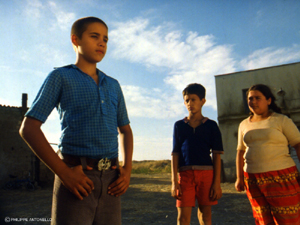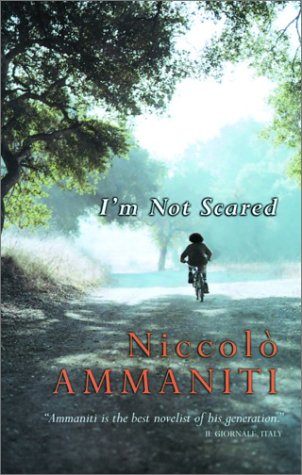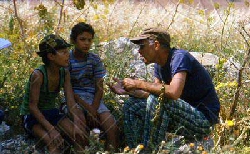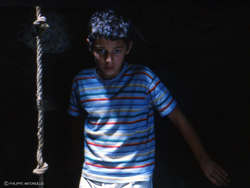
We're an all volunteer website and need your help to keep going. Here are five ways you can contribute: 1 Donate 2 Buy something 3 Submit a story 4 Volunteer 5 Advertise

New in the gift shop, virtualitalia.com logo wear and use items! 
|
PLEASE NOTE: We are experiencing unexpected
technical difficulties caused by our web host. We apologize for
the inconvenience. During your visit you may experience service
and page interruptions - we are in the process of fixing everything and hope to be
fully back on our feet soon.
i'm not scared:the film
Those words come early in Io non ho paura (I�m Not Scared), Niccol� Ammaniti�s vivid and suspenseful novel of the unraveling of childhood, but it isn�t until the end of the story that the terrible promise embedded in that declaration of ownership is revealed. Ammaniti�s Viareggio prize-winning novel, set during Italy�s anni di piombo (the terrorism- and kidnapping-riddled 1970s) in the fictional deep-southern town of Acqua Traverse, struck a definite chord with Italians, selling a nearly unprecedented 700,000 copies since its publication in 2001. The film version by Oscar-winning Italian director, Gabriele Salvatores, has proved an equal success: Two days after Io non ho paura appeared at the Berlin Film Festival in February 2003, thirty-two countries had purchased the film; the reviews since then have been raves, virtually without exception. I�m Not Scared opened in San Francisco on April 23, 2004 at the Embarcadero Center Cinema. In a 2003 interview for Rome�s L�Unita, Ammaniti recalled that the genesis of Io non ho paura was a road trip he took to Puglia in the late 1990s: �After Caserta, leaving the Apennines behind, you come upon a hinterland that, during the summer months, is completely covered in wheat. There are no trees, there�s no shade, there�s nothing there, just waves of wheat. It�s a surreal place. �Looking at these vast, empty expanses with only a few houses scattered around, I imagined what life must have been like for the families who lived there twenty years ago. I asked myself what the children who lived there would have done when school was out for the summer. And that�s how the story was born.... I liked the idea of the countryside in the summer ... a place that, in the imagination of a child ... might be populated by monsters both real and imaginary.� True to that vision of a place �populated by monsters both real and imaginary,� Salvatores shot I�m Not Scared in locations in Puglia and Basilicata, with a primary set in the countryside near Melfi (population roughly 16,000), due north of Potenza. But Io non ho paura has an historical point of departure as well: It is set in 1978, the year in which kidnappings in Italy reached an all-time peak of nearly 600 (including, famously, that of Aldo Moro). That was also the year in which the Italian government froze the financial assets of the families of kidnap victims in a desperate bid to discourage ransom demands. Typically, those chosen for kidnap came from wealthy families in the north and were transported to hiding places in Sardegna and in the forgotten reaches of the mezzogiorno. At the same time, though many of the 1970s kidnappings were politically motivated, a large number were carried out against children, with the frank intention of extorting money from distraught parents.

Io non ho paura imagines such a crime, imagining further that the victim is discovered by another child, his age mate, who can scarcely comprehend how the filthy creature he has found, chained at the bottom of a pit behind a house abandoned in the fields, came to be there. What Ammaniti wanted to explore, he said, was precisely that struggle to absorb a horror: �How does a child react to a kidnapping if he doesn�t know what a kidnapping is?�
In Salvatores� version, the film�s pace parallels the emotional processes of awareness, recoil, and renewed determination of its ten-year-old protagonist, Michele (Giuseppe Cristiano), whose eye and consciousness quite literally frame what Salvatores and cinematographer Italo Petriccione chose to put on the screen. Specifically, Salvatores resolved that his camera would never deviate from Michele�s point of view�in other words, that the audience would see nothing and know nothing that Michele himself did not directly experience. In literary terms, that focus on a single character�s perspective can be the engine that transforms a novel into a juggernaut�the mind of a well conceived character has the potential to populate a world. It is, however, a risky choice for a film, where the single-perspective focus can turn claustrophobic. In I�m Not Scared, significantly, it never does. Instead, by �forcing� his audience to digest events precisely as his boy hero does�in between scenes in which Michele imagines monsters in the dark, covets a friend�s expensive new toys, and, in an episode reminiscent of Italo Calvino�s child hero in Il Barone Rampante (The Baron in the Trees), climbs into a carob tree and peevishly refuses to come down until his parents treat him better�Salvatores provides one of the film�s most distinct pleasures: the time to think about what is happening. In transferring the novel to the screen, Salvatores worked closely with Ammaniti (who, together with Francesca Marciano, fashioned the screenplay), conceiving a remarkably faithful amplification of the novel�s themes and mood, recreating not only Ammaniti�s striking visual imagery but finding ways to reproduce the novel�s aural landscape as well. Ammaniti�s Io non ho paura, for example, is filled with the drone of cicadas, the susurrus of wind passing through expanses of wheat, the skirl of bicycle wheels on dirt roads. Salvatores� answer was a lush, evocative soundscape provided primarily by a string quartet (the masterful Quartetto d�Archi di Torino) that includes original music by Ezio Bosso and Pepo Scherman as well as work by Canadian Michael Galasso, whose minimalist, Philip Glass-like solo violin resonates powerfully in the film. (Clips from the soundtrack can be heard at Io non ho paura�s official Italian website.)
Among his discoveries, Salvatores said, was that �until a certain age, it�s difficult for children to narrow their focus on specific objects. So, for instance, if I�m looking around the room and I say, �What interests me is that object way over there�look at that and ignore everything else,� in order to focus on what you mean, a child will walk up close to the object. So that (close-up) point of view is in our histories as human beings, it�s in our memories, and that�s why I used that perspective in the film.� An understanding of children�s relationship to color, too, went into Salvatores� thinking. �Children don�t draw with shades of colors,� he noted. �They draw with primary colors�red, yellow, blue, green. Because, according to the way they see, shades confuse things. They need the real colors. So, in part because of that, we used a very strong, very specific color technique in the film.� Those �real� colors do, indeed, vibrate on Petriccione�s screen, nourishing the eye and lifting the natural, untrammeled beauty of the Lucanian landscape from the level of mere �scenery� to a role as essential as that of any cast member. (An all-too-brief scene of a thunderstorm, for example, is filmed so gorgeously that you�ll think you�ve never seen it rain before.) In Ammaniti�s and Salvatores� vision, of course, beauty conceals as much as it reveals.

Salvatores, born in Naples in 1950 (though he has lived most of his life in Milan), remains fascinated by the south of Italy, a �magical place,� he says, �that is full of contrasts.� I�m Not Scared is no less so, and the story draws its ultimate equilibrium precisely from the clash of opposites: the idyllic beauty of the countryside vs. the evil that lurks beneath, the world of children vs. the world of adults, acts of selflessness vs. acts of infamy.
And therein lies one of the most daring aspects of I�m Not Scared: its willingness to expose a view of Italy�and, specifically, of the south of Italy�that runs counter to the usual export fare. For his part, Salvatores intended Io non ho paura to challenge the kind of Italian film that typically becomes popular on the foreign market: �the beautiful ocean, the nostalgic past, mafia, pizza, and mandolins,� Salvatores quips. In an ironic twist that illustrates Salvatores� point, non-Italian reviews of I�m Not Scared frequently misidentify the film�s setting as either Tuscany or Sicily, exposing the kind of assumptions about Italy that continue to run deep in the public consciousness: If it�s beautiful and agrarian, it must be Tuscany; if it involves crime, it must be Sicily. What Salvatores wanted to say first with Io non ho paura, he explains, was this: �Let me show you a place that�s desolate. Beautiful�because it is beautiful. But let me assure you that life is hard there. I wanted to show that the nature is marvelous, but that there�s also a sense of isolation, of abandonment. Don�t forget that Michele�s mother says to him at one point, �When you grow up, promise me that you�ll leave here and never come back.� That�s also part of the story of this place.� Commenting for Tempi Moderni on his 1997 science-fiction film, Nirvana, Salvatores noted that �talking about the future is always a pretext for talking about something else.� If that is true, perhaps talking about the Italian south also sometimes serves as a pretext for talking about other things. Indeed, the mezzogiorno appears often in Italian literature (and particularly in films) as a kind of �heart of darkness,� a screen upon which other preoccupations are projected. The south of Italy, Salvatores acknowledges, �is our guilty conscience.� Perhaps it was to be expected, then, following the San Francisco press screening of I�m Not Scared in late March, that Salvatores would be asked repeatedly to talk about the connection between the historical kidnappings and the Italian south. �We knew it would be a problem of the film,� Salvatores later acknowledged. �The fact is that the kidnapping is one of the narrative mechanisms of the film and made it an interesting story to tell, and we realized that, for an Italian, that topic might even be a little embarrassing. But these things did happen. It�s a little like when Americans make films about Custer who murdered the Indians. It is a criticism in a certain sense, but we all have to accept our defects. �At the same time, the film is not about kidnapping. We were looking to focus beyond that on the path this boy (Michele) takes, but it�s certainly true that his metaphorical journey requires more effort to see.�

Not far into I�m Not Scared, Michele and his customary band of summertime friends set off on their bikes in search of something�anything�new to do. They pedal on dirt paths across the scorching fields of grain that surround Acqua Traverse until they come upon something amazing: a hill rising out of the eternal flatness of the plains and, on its flank, a collapsing, abandoned house. They�ll climb the hill, of course, and of course it will be a race to see who reaches the top first, and of course the winner will be Teschio (Fabio Tetta), the oldest, the cruelest, and the unofficial captain of the group. At the summit, predictably, Teschio is already waiting beside the ruins of the house when Michele and the rest arrive. �This place is mine,� he declares. �What do you mean, it�s yours?� Michele asks. �It�s mine,� Teschio says. �I saw it first. Things belong to whoever finds them first.� For Teschio, edging toward adulthood and already positioned to follow in the footsteps of his older brother, Felice (Giorgio Careccia), a small-town criminal whose viciousness the children fear instinctively,the declaration is superficial: Teschio�s concept of control is limited to the tangible universe, and ownership for him is an end in itself. Nor is he particularly courageous. Having conquered the house, Teschio sends Michele to explore it, half-hoping the younger boy will crash through the rotting floor. Instead, what Michele discovers there is Filippo, held prisoner at the bottom of a pitch-dark hole, and the more important secret of the kidnapped boy becomes Michele�s even if the house belongs to Teschio. Michele, of course, is made of different stuff, and �ownership� of what he has found leads him initially to construct a kind of personal fable in an attempt to explain Filippo�s presence (Michele first imagines that Filippo must be his own, forgotten brother). But fantasy gives way to reality as Michele grasps the truth, embarking, as he does so, on the �metaphorical journey� that Salvatores describes.
�There�s a lovely poem by Pasolini that fits in here,� Salvatores continues, �in which he asks, �What is it that would make you put your own life at risk if not for the discovery that other people are at least as important as you are?� And that�s the passage toward adulthood.� That passage, of course, requires Michele to absorb a sad wisdom. That, too, belongs to him forever, his prize for having found Filippo �first.� �When you begin to understand that other people�maybe even including your parents�aren�t only good or bad, but can be good and bad at the same time, but you love them anyway�at that point, you�re an adult,� says Salvatores. �When you discover that, what belongs to you then �what becomes your �property,� so to speak�is substantially, simply, yourself.� Related Articles:
about the author |
© 1998-2005 by virtualitalia.com unless otherwise noted
 �Things belong to whoever finds them first.�
�Things belong to whoever finds them first.�

 But because Salvatores� I�m Not Scared is a film, the job of making a first impression falls naturally to its visual language, a wand that Salvatores and Petriccione wield like a pair of wizards. Indeed, Salvatores revealed during a recent interview at San Francisco�s Istituto Italiano di Cultura, his preparation for the making of Io non ho paura specifically included research into the way children process visual information.
But because Salvatores� I�m Not Scared is a film, the job of making a first impression falls naturally to its visual language, a wand that Salvatores and Petriccione wield like a pair of wizards. Indeed, Salvatores revealed during a recent interview at San Francisco�s Istituto Italiano di Cultura, his preparation for the making of Io non ho paura specifically included research into the way children process visual information.

 Indeed, I�m Not Scared becomes art precisely at the point at which it launches into the hero�s tale: Michele, having literally descended into the pit, rises again to begin the struggle to manifest his new knowledge, to call forth that which is unique within him. Says Salvatores, �At the end of his story, Michele becomes a man because he chooses something different from what others have decided for him or tried to impose upon him. He gains faith in himself, and (at the same time), he gains a relationship with another person.
Indeed, I�m Not Scared becomes art precisely at the point at which it launches into the hero�s tale: Michele, having literally descended into the pit, rises again to begin the struggle to manifest his new knowledge, to call forth that which is unique within him. Says Salvatores, �At the end of his story, Michele becomes a man because he chooses something different from what others have decided for him or tried to impose upon him. He gains faith in himself, and (at the same time), he gains a relationship with another person.